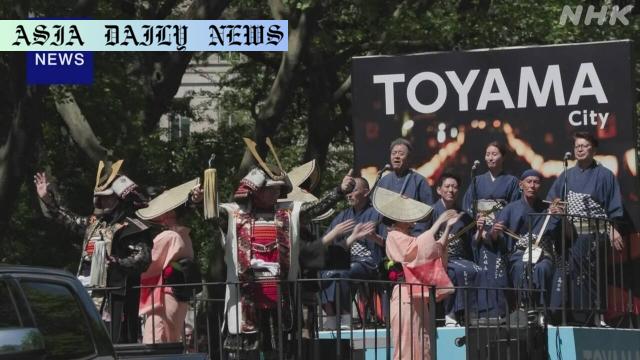Toyama stood out with its traditional ‘Owara Kaze no Bon’ dance and tourist promotions in New York’s Japan Parade.
- Toyama featured in New York’s Japan Parade, promoting its culture.
- The ‘Owara Kaze no Bon’ dance represented Toyama’s unique festival spirit.
- A booth for Toyama tourism highlighted attractions like Toyama Castle.
- Mayor Fujii Hirohisa’s participation emphasized regional hospitality.

New York’s Japan Parade: A Grand Celebration of Japanese Culture
On Saturday, New York City came alive with the annual Japan Parade, an event that has grown to become a spectacular showcase of Japanese culture and traditions. This year, the parade held special significance for the city of Toyama, which was prominently featured in the festivities. As part of this vibrant cultural event, groups representing various Japanese prefectures, including Wakayama and Tokushima, filled the streets along Central Park with captivating performances. Notably, Toyama brought its unique flavor to the event with its traditional dance, ‘Owara Kaze no Bon,’ a cultural gem typically performed during an annual festival in the city.
The parade serves as an avenue to bridge cultural gaps and bring people closer to Japan’s multifaceted heritage. In addition to dance and drum performances, the city of Toyama took the opportunity to promote itself as a travel destination. Invited to participate due to its recognition by The New York Times as one of the ’52 Places to Go in 2025,’ Toyama has made a mark by highlighting its cultural and historical richness through its participation.
Toyama’s Cultural Showcase: More Than Just a Parade
The people of Toyama visibly added a distinct element of cultural pride to the Japan Parade. This year, their iconic ‘Owara Kaze no Bon’ dance grabbed center stage, a dance that exudes grace and profound historical significance. As they swayed to the ethereal music at the parade, they also drew in onlookers’ attention to a region of Japan often overlooked by international tourists. With its tranquil beauty and reverence for tradition, Toyama is a destination worth exploring beyond the often-treaded paths of Tokyo, Kyoto, and Osaka.
Mayor Fujii Hirohisa of Toyama embodied the spirit of this representation. Dressed in traditional Japanese armor, he not only led the parade with elegance but also symbolized the city’s commitment to showcasing its heritage. Furthermore, Toyama’s booth at the event became a popular spot, catching the curiosity of visitors with promotional materials depicting iconic sites such as Toyama Castle. By distributing towels and brochures, representatives creatively engaged with those keen to discover more about Toyama, encouraging them to explore beyond Japan’s urban hubs.
Why Regional Japan Deserves More Attention
In the bustling corners of New York, amid the vibrant colors and harmonious beats, one message stood clear: regional Japan has so much to offer. The inclusion of Toyama in this year’s parade emphasizes a growing effort to redirect international tourists towards lesser-known gems. In his remarks, Mayor Fujii highlighted how Toyama, with its rich culinary offerings, such as local sake, and its warm hospitality, provides a window into authentic Japanese traditions.
For regional cities like Toyama, leveraging platforms such as the Japan Parade creates opportunities to represent their identity and foster global connectivity. By reaching a wider audience, they can illustrate the rewards of venturing off the beaten path, fostering a deeper cultural exchange between Japan and the world. Events like these allow the world to experience Japan’s diverse landscape, and in turn, create avenues for local economies to thrive through tourism.
The Future of Toyama’s Tourism Efforts
Toyama’s appearance at the Japan Parade may just be the start of its growing prominence as a tourist destination. By harnessing support from international publications such as The New York Times and participating in renowned global events, the city is carving a unique narrative. This approach not only uncovers hidden treasures within regional Japan but also highlights Toyama as a pioneer for other regional municipalities seeking visibility on the global platform.
Looking ahead, the challenge lies in sustaining interest and translating it into long-term tourism growth. As Toyama continues to position itself as a destination full of rich heritage and unique traditions, it must also adapt to the demands of a global audience while preserving its authenticity. Strategically promoting eco-tourism, local craftsmanship, and year-round attractions could further enhance its appeal and ensure a flourishing future for Toyama on the international stage.



Commentary
Celebrating the Spirit of Cultural Exchange
The Japan Parade in New York serves as more than just a cultural celebration; it’s a bridge that brings together communities separated by vast oceans. This year, the prominent inclusion of Toyama was a refreshing reminder that there’s so much more to Japan than the famous tourist destinations we often hear about. The vibrant display of the ‘Owara Kaze no Bon’ dance, accompanied by the city’s promotion of its attractions, beautifully captured the essence of Toyama’s allure and traditions.
The Hidden Gems of Toyama
While cities like Tokyo or Kyoto usually dominate discussions about travel to Japan, regional cities such as Toyama hold incredible treasures waiting to be discovered. Through events like these, they have a chance to break through misconceptions that Japan begins and ends with its major cities. From its historic landmarks to its festivals steeped in tradition, Toyama offers a welcoming window into authentic Japanese life without the rush and congestion of urban destinations.
What Events Like These Mean for Global Travel
Events such as the Japan Parade not only enrich the cultural understanding of participants and onlookers but also foster curiosity and inspiration to explore. Mayor Fujii’s initiative to bring Toyama’s warmth and hospitality to New York reflects a growing movement to encourage global audiences to connect with regional Japan. These humanizing experiences remind us that travel isn’t just about seeing new places but also about building bonds with people and cultures. Overall, Toyama’s involvement in the parade was a beautiful blend of tradition, innovation, and global outreach—a step in the right direction for international cultural exchange.